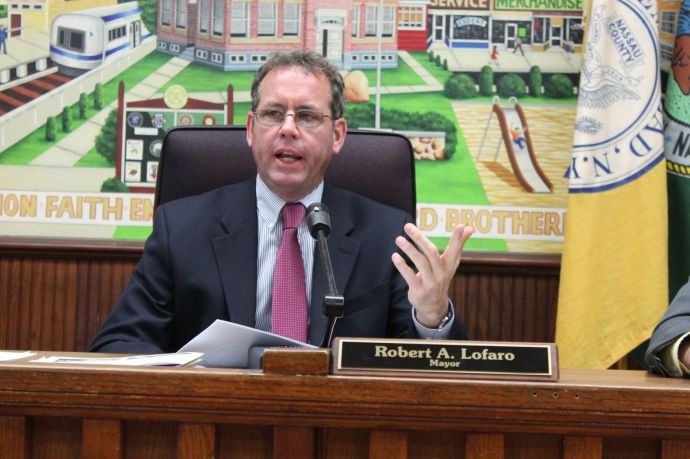A lack of information and inadequate public outreach led the Village of New Hyde Park to officially oppose the Long Island Rail Road’s plan for a third track, Mayor Robert Lofaro said Tuesday.
Lofaro said he and other officials were frustrated that the scoping document for the proposed $1.5 billion project contained so much detail about plans to eliminate seven street-level crossings along the 9.8-mile corridor but so little about the third track itself.
“It’s not fair to the public to say, ‘We want to do this,’ and not really let the public understand the ramifications to their property and the impact to their homes,” Lofaro said after Tuesday’s Village Board meeting.
Gov. Andrew Cuomo announced plans in January to install the third track along the LIRR’s Main Line between Floral Park and Hicksville, reviving a Metropolitan Transportation Authority proposal that met hot community opposition in 2005.
Cuomo has sought to distinguish his plan from the older one, promising that it would not require any residential property acquisitions, be built entirely within the LIRR’s right of way, and come with the elimination of the seven street-level crossings.
Lofaro previously said the village would oppose the project unless the crossings were removed.
After waiting for more information before taking a stance, New Hyde Park officials will appear at a press conference Thursday with state Sen. Jack Martins (R-Old Westbury) and other village officials to state their opposition, Lofaro said.
“The information that’s now coming out to the public, we think, is lacking,” he said.
In a statement Wednesday, Cuomo transportation spokeswoman Beth DeFalco said planners incorporated Lofaro’s suggestions about the grade crossings into the scoping document after meeting several times with him and other local officials.
“The mayor cannot now have it both ways — working with us to make changes to the project and then publicly opposing the project,” DeFalco said.
The times and locations for upcoming public meetings for residents to give feedback about the scoping document also concerned New Hyde Park officials, Lofaro said.
Planners added two public meetings to the four scheduled for next week after officials from four villages told planners the times were inconvenient for many residents in the affected area, he said.
Lofaro said the village also took issue with the scoping period for public comment being just more than a month long, compared to 90 days for the MTA’s earlier proposal.
“The proposed length of the scoping period exceeds that required by law while the number of public meetings held will be six times what is required,” DeFalco said in a statement.
There will now be two meetings at the Inn at New Hyde Park on May 24 at which residents can give feedback to the scoping document and express concerns — one from 11 a.m. to 2 p.m. and another from 5 to 9 p.m. — and two at Hofstra University. Meetings will also take place at the “Yes We Can” Community Center in Westbury and Antun’s catering hall in Hicksville.
New Hyde Park officials will also host a public information meeting at 7:30 p.m. Thursday at the New Hyde Park Road School.
The eight Main Line villages may retain Manhattan environmental law firm Beveridge & Diamond to represent them as the project develops, officials said Tuesday.
Affected villages retained the firm in the mid-2000s, Lofaro said, and are now considering an inter-municipal agreement to hire the firm collectively to reviewing plans and start court proceedings if necessary.
Village of Mineola Mayor Scott Strauss said he is uncertain whether Mineola will sign on to the agreement. The village has hired an urban planner to review plans.
Strauss said Mineola does not yet oppose the project outright, but he agreed the scoping document and the hearing process were concerning.
“What I’m opposing is how it’s being done, how this is being rolled out to us,” Strauss said. “They’re asking us to put a puzzle together and see how it fits into our community, but they’re not giving us all the pieces.”
DeFalco said planners have held more than 100 meetings with local stakeholders so far in a “truly unprecedented” outreach effort.
“This engagement started in January and will continue through an intensive scoping period and beyond,” she said.
The state has launched a website, AModernLI.com, and opened an information center at the Mineola LIRR station where the public can review the scoping document, ask questions and submit comments on the proposal. The information center is open Tuesdays and Wednesdays from 11 a.m. to 7 p.m., Thursdays and Fridays from 7 a.m. to 3 p.m. and Saturdays from 10 a.m. to 3 p.m.
Cuomo and other proponents, including business groups, universities and non-profit institutions, say the third track would east commutes, improve train service, reduce road traffic congestion, add millions of dollars to Long Island’s economy and attract thousands of new residents.
Local opponents say their homes, schools and quality of life would bear the brunt of the project and get little to no benefit.

